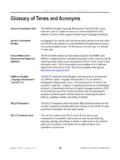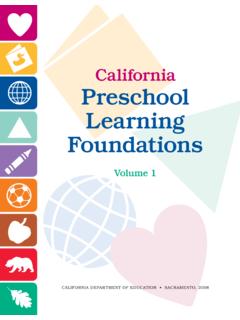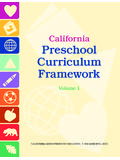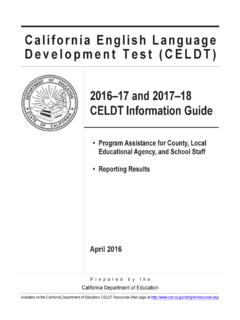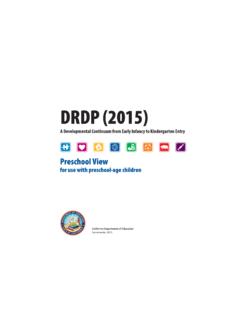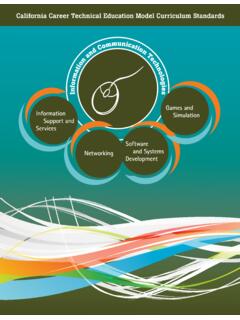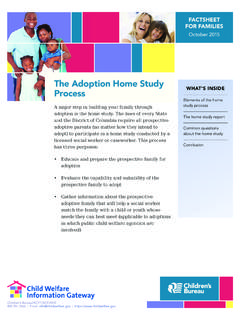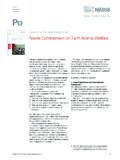Transcription of School Attendance - Child Welfare & Attendance …
1 T OF. EN ED. U. TM. CA. AR. T IO. DEP. N. ST. IA. A. Publishing Information N. TE R. FO. OF C A LI. The School Attendance Improvement Handbook was developed by the Safe Schools and Violence Prevention Office, California Department of Education, and was published by the Department, 721 Capitol Mall, Sacramento, California (mailing address: Box 944272, Sacramento, CA 94244-2720). It was distributed under the provisions of the Library Distribution Act and Government Code Section 11096. 2000 by the California Department of Education All rights reserved ISBN 0-8011-1505-1. Ordering Information Copies of this publication are available for $ each, plus shipping and handling charges. California residents are charged sales tax. Orders may be sent to CDE Press, Sales Office, California Department of Education, Box 271, Sacramento, CA 95812-0271; fax (916) 323-0823. See the back of this book for complete information on payment, including credit card purchases, and an order blank.
2 Prices on all publications are subject to change. A partial list of educational resources available from the Department appears on pages 85-86. In addition, an illustrated Educational Resources Catalog describing publications, videos, and other instructional media available from the Department can be obtained without charge by writing to the address given above or by calling the Sales Office at (916) 445-1260. Notice The guidance in the School Attendance Improvement Handbook is not binding on local educational agencies or other entities. Except for the statutes, regulations, and court decisions that are referenced herein, the document is exemplary, and compliance with it is not mandatory. (See Education Code Section ). iii Contents Acknowledgments .. v Chapter One: The Importance of School Attendance .. 1. A Framework for Understanding and Preventing Truancy .. 2. Prevention and Intervention Funding Sources .. 8. Chapter Two: Truancy Prevention Programs.
3 9. Keeping Students in School Makes Sense SB 727 .. 9. Components of a Comprehensive Truancy Prevention Strategy .. 10. Board Policies .. 10. School Norms .. 11. Signs .. 12. Community Norms .. 13. Community Partners .. 14. Parental Involvement Level 1 .. 15. Extended Learning Opportunities .. 17. Preschool and Early Childhood Education .. 18. Staff Development and Classroom Management .. 18. Service Learning .. 19. After- School Programs .. 20. Independent Study .. 22. Rewards, Incentives, and Recognition .. 22. Safe Schools, Safe Passages, and Positive School Climates .. 23. Conflict Resolution .. 24. Counseling and Guidance .. 24. Pupil Empowerment .. 25. Closed Campuses .. 25. Integrated Services Initiatives .. 26. Comprehensive School Health System .. 27. Health Framework .. 27. iv Contents California Healthy Start .. 27. Family Resource Centers .. 28. Drug and Alcohol Prevention Programs .. 28. Key Considerations for an Effective Attendance Program.
4 28. Chapter Three: Early Intervention Programs and the Value of Partnerships .. 31. Student Study Teams and Student Success Teams .. 32. Parental Involvement Level 2 .. 33. Outreach Programs and Home Visits .. 33. Truancy Sweeps .. 35. School Resource Officers .. 35. Mentoring and Tutoring Programs .. 37. Peer Helping and Conflict Management .. 38. The Alternative Education Option .. 39. School Attendance Review Boards .. 41. Chapter Four: Legal Intervention Tools .. 45. CalWORKS Program .. 46. Suspension and Expulsion Options .. 47. Parental Involvement Level 3 .. 48. Community Service .. 49. Citation .. 50. Vehicle Code .. 51. Daytime Curfew .. 51. Juvenile Court .. 52. Operation Stay in School .. 52. Work Experience .. 53. District Attorney Mediation .. 53. Alternative Education Placements .. 54. Conclusion .. 56. Appendixes A. Resources on School Attendance .. 57. B. California Code Sections Relating to School Attendance .
5 64. C. Sample First, Second, and Third Truancy Letters Prior to SARB .. 68. D. Sample Memorandum of Understanding Between Sacramento County Department of Human Assistance and Sacramento City Unified School District .. 71. E. Sample Agreement for Deputy Probation Officer Services at District Schools .. 74. F. Truancy Ordinance (No. 862) of the City of Folsom .. 79. vv Acknowledgments The California Department of Education Safe Schools and Violence Prevention Office thanks the following people for their time and expertise in shaping this document: Sue Bennett, Administrator, Educational Options Unit, California Department of Education Bob Burgess, Director of Student Services, San Leandro School District John Burton, Fontana Unified School District J. Peter Cahn, Coordinator of Special Projects, California Association of Directors of Activities Madalyn Craviotto, Social Services Program Planner, County of Sacramento De- partment of Human Assistance Sherrie Crow, Placer County Peer Court Coordinator Alan Del Simone, Administrator, Student Welfare and Attendance , West Contra Costa Unified School District Leslie Fritz, Director of Education, California Parks and Recreation Society Rob Gerig, Director of Pupil Services, Sacramento City Unified School District John Gilroy, Field Representative, California Department of Education Karen Green, Placer County Peer Court Coordinator Marie Gutierrez, SARB Facilitator, Sacramento City Unified School District L.
6 P. Hartzler, Consultant, Alternative Education, California Department of Education Sharon Hicks, Community Liaison and Parent Adviser, Elder Creek Elementary School District Ruth Holton, Principal, Stella Hills Elementary School District, Kern County Paul Huard, South Lake Tahoe Police Department Debbie Jeter, Deputy Director, San Luis Obispo County Department of Social Services Jillian Barr Joncas, ERIC Counseling and Student Services Clearinghouse Tom Joynt, Director of Alternative and Adult Education, Petaluma City Elementary School District vi Acknowledgments Tad Kitada, Director, Prevention Services, Placer County Office of Education Dustin Laswell, Detective, Folsom Police Department Rita Marinoble, Department of Counselor Education, California State University, Sacramento Sgt. Maj. Mike Mendoza, Site Coordinator, Mather Youth Academy Debbie Morris, Director of Child Welfare and Attendance , North Sacramento Elementary School District Jeanette Murphey, Recreation Coordinator, Saddleback Valley Unified School District Don Northcross, Deputy, Sacramento County Sheriff's Department Marco Orlando, Consultant, California Department of Education Jerry Piper, Student Services Supervisor, Bakersfield City School District Marissa Rosoff, Child Welfare and Attendance Specialist, Burbank Unified School District Neil Smart, Community Services Director, City of Healdsburg Norman Smith, Student Attendance Office, San Francisco Unified School District Joe Taylor, Administrator, Child Welfare and Attendance , Sacramento County Office of Education Jim Thompson, Director, Mather Youth Academy Vicki Walker, PAL Program Coordinator, Orange County Office of Education Patty Wills, Child Welfare and Attendance Specialist.
7 San Juan Unified School District Susan Wilson, Deputy District Attorney, Sacramento County Glenn Wold, Assistant Principal, Hoover Middle School , San Francisco Darryl Yagi, Casa Grande High School , Petaluma California State University, Sacramento, social work graduate students: Debra Smith, Lisa Marcotte, Yen Thi Nguyen, Marvie Paulson 1. Chapter One The Importance of School Attendance R. It is further the policy of the egular School Attendance is a necessary part of the State Board of Education that the learning process and the means to graduation with a substantial benefit students will good education. Students who are frequently absent may derive from regular Attendance in be putting their futures in jeopardy. Chronic absenteeism, espe- a safe and orderly School environ cially truancy, is a behavior that is highly associated with drop- ment justifies a high priority and ping out of School . Regular Attendance is essential for success in commitment of personnel and School .
8 Fiscal resources by the Depart Efforts to improve School Attendance cannot be separated ment of Education and by local from the larger School reform picture. Safe and healthy schools . educational agencies. ones that employ a challenging curriculum and reinforce high expectations for academics, behavior, and social responsibility . California State Board of Education, Policy on School Safety, Discipline, are schools that give students the motivation to attend. and Attendance The purpose of this book is to showcase strategies that have worked to break the cycle of failure that undermines some stu- dents' self-esteem and causes them to avoid School , and to high- light strategies that encourage students to bond with their schools. While it is not feasible to address all School reform strategies in this document, many strategies are summarized in order to em- phasize the vital link between effective educational strategies and student Attendance rates.
9 Where there are students who are not bonded to School , there will be a loss to society of those stu- dents' future productivity, and to a School 's average daily atten- dance ( ) credits. School absence is a student missing from School or class with or without the prior knowledge and consent of either parents, guardians, or School personnel. A student not in class but on a School -approved activity is not considered truant. A truant is any student who is absent from School three times in the same School year without good reason or without permis- sion from home or School (Education Code Section 48260). Tru- ancy becomes a serious problem at middle School and high School levels but can become a problem as early as elementary School . 2 Chapter One Absenteeism hurts the student. Students Attendance . When students are absent, who are frequently absent fall behind in the School loses money. academics and miss important social- Absenteeism hurts the community.
10 Stu- ization concepts that enhance their abil- dents who are truant are more likely to ity to understand and follow directions be involved in criminal activity. For or, ultimately, plan for the future. example, San Diego reported that 44. High School dropouts are two-and-a- percent of violent juvenile crime oc- half times more likely to be on wel- curred between 8:30 and 1:30 fare than high School graduates and In addition to the cost of the crime it- are almost twice as likely to be un- self, add the costs to the community employed, according to a De- when juvenile dropouts fail to become partment of Education 1996 finding. productive members in the community, Studies show that truancy frequently are added to the Welfare roles, or be- leads to criminal activity, drug use, come a part of the working poor and and incarceration. need a disproportionate number of so- Research has found a clear link be- cial services. tween academic failure in the early Absenteeism hurts businesses.

